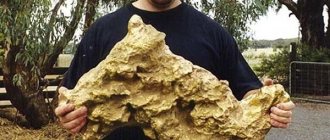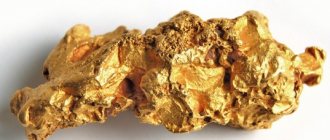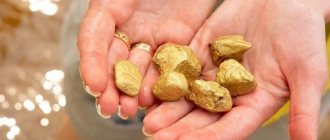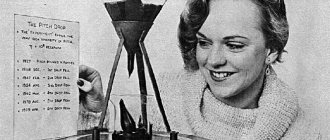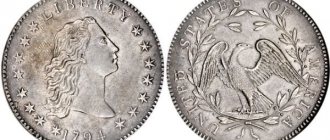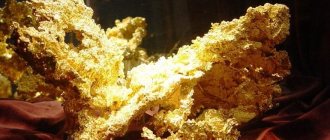Hello!
The development of primary deposits provides up to 97% of the volume of gold mined in the world. As a rule, they contain precious metal mixed with ores. To obtain it in its pure form, it is necessary to carry out a number of additional operations.
A more rare occurrence is native gold extracted from the depths with a minimal amount of impurities. However, it is precisely this that is most valued by private miners.
What is a gold nugget
A gold nugget is a pure or minimally ore precious metal. It can have different shapes and sizes. Particularly large specimens weighing up to a hundredweight, and sometimes more, are valued.
Story
Native gold is the very first rock that humanity became familiar with. In ancient times, this stone was found in river valleys. The glitter of gold was noticed back in Paleolithic times. At this time, people realized that this breed was not suitable for making household items. Therefore, for many years, gold was simply looked at. It was perceived as an unusually beautiful material. Only at the turn of the III-IV centuries. BC. gold began to be used in the production of jewelry.
Somewhat later, native gold began to act as an object of exchange. At the beginning of the 19th century, gold-bearing placers in the Urals were discovered. In the second half of this century, the “gold rush” began. This phenomenon occurred in Alaska. A lot was found, but even more sand was dug up in search of this metal.
Gold items were discovered during excavations of the most ancient civilizations of the Neolithic era in the mountains of France, in Celtic burial grounds, in the predynastic monuments of Egypt, among the most ancient cultural layers in India and China. The refining of gold and its separation from silver began in the 2nd half of the 2nd millennium BC. The first studies were related to the development of alchemy, the main goal of which was to create gold from base metals.
How are gold nuggets formed and where can you find them?
Precious pieces of rock are formed in the bowels of the earth. It takes a long time for native gold to form. The exact conditions of the precious fragments are unknown to scientists to this day. There are several versions of this process. The most popular are:
- Gold grains are attracted to ore deposits.
- Native gold is the remains of ancient large veins that have been destroyed.
Some characteristic features allow us to determine the likely locations of pure precious metal ingots:
- proximity to the junction of tectonic plates or traces of volcanic activity;
- area of occurrence of ore or placer gold;
- lack of nearby silver mines.
How to determine the presence of precious metal in a stone
The authenticity of native gold is determined in the field or at home using a folk method.
- If the golden inclusion under the mineral layer is barely noticeable, the stone is chipped or broken. When struck, the precious metal does not crumble.
- Having provided access to the inclusion, its surface is scratched with a steel needle.
- The scratched area is examined through a magnifying glass. The gold-containing element will not be destroyed; lines will remain on it where the needle is pressed.
The presence of gold dust in a stone is checked using iodine. An alcohol tincture from a pharmacy is suitable.
- Grind the mineral into powder.
- Place the mineral powder in a jar or other container.
- Pour iodine into the powder and stir until smooth. Wait until a precipitate forms.
- Immerse a strip of white paper towel or filter paper (2 cm wide) into the liquid so as not to stir up the sediment. Immediately remove and dry at room temperature.
- The action of the previous paragraph is repeated 4–7 times.
- After drying, the paper is placed on a heat-resistant saucer and set on fire. If the stone contains precious metal, the ash will be purple in color.
There are few stones containing gold-bearing inclusions. The precious metal is found in granite, quartz and quartz diorites. Not all shiny minerals are classified as valuable specimens. But varieties of pyrite, sphalerite, galena and stibnite often lie next to the precious metal.
See an alternative option for finding gold:
Review of the largest finds
How much do the largest nuggets mined from the depths weigh? Depending on the luck of the miners, you can find ingots whose weight varies from several grams to tens of kilograms.
Expert opinion
Vsevolod Kozlovsky
6 years in jewelry making. Knows everything about samples and can identify a fake in 12 seconds
The most successful finds end up in the book of records and participate in specialized exhibitions. Subsequently, they are either sent for remelting (in 95% of cases) or left as a visual aid.
In the world
In world practice, the largest nugget is the “Holterman plate”. It was discovered in 1872 in Australia at one of the quartz mines. The weight of the found cobblestone was 250 kg, of which 93 kg was pure gold. It was later melted down to make jewelry.
Since the block for the most part did not contain native gold, but quartz inclusions, scientists are still arguing whether it can be called a nugget. Many agree that it was just a piece of vein. However, even in this case, it remains the largest in the history of gold mining.
A few years earlier, in 1869, the record holder was the “Welcome Stranger,” which was found right on the road. Two fellow miners returning from work discovered a lump of native gold in the mud where their cart was stuck.
Weighing showed that the weight of the ingot is 71 kg. It is noteworthy that to determine the mass of the block it had to be cut into several parts due to the lack of suitable scales.
No less remarkable was the discovery of a piece of native gold in California (USA). While digging the grave of his comrade and colleague, a local town prospector came across a large cobblestone. After extracting the stone to the surface, it turned out that it was in fact native aurum. Wanting to pay his last respect to his comrade, the miner named the 36 kg nugget after him - Oliver Martin. Subsequently, the stone was sold for 22.7 thousand dollars.
In Russia
Like Japan, Russia is considered a country rich in gold, but most of it is represented by medium and small placers. However, there are also impressive representatives. The most famous of them is the Russian Precious Triangle. The native block was discovered in 1842 in the Southern Urals. In addition to its size, the stone has one more feature - it was found by an 18-year-old guy in a mine that until that moment was considered completely exhausted.
Another representative of especially large native gold ingots was discovered in 1895. His weight was 31 kg. The mass of subsequent finds did not exceed 20 kg.
Types of deposits
The global gold mining industry uses directly gold deposits and complex deposits containing the precious metal as a raw material base. How does gold appear? There are two types of metal deposits in nature: bedrock and alluvial.
Primary deposits are primary, since their appearance is associated with magmatic processes. The Earth's magma itself is characterized by a high concentration of precious metal. During the process of volcanic activity, it erupted onto the surface of the planet and then began to cool. But, since it contains many elements, cooling occurred unevenly. The most refractory substances crystallized first, then the more fusible components were shot into the surrounding rock, forming veins. The solutions of gold-containing salts were the last to cool.
The reasons for the presence of gold in nature in the form of alloys with other elements are also explained by magmatic processes. The composition of magma in different places could differ; the ratio of the composition components, as well as the conditions for the formation of veins, are not constant values. For this reason, different deposits differ from each other in the composition of the main rock and gold alloy, the shape and location of gold-bearing veins, and the conditions for mining the precious metal. The most common impurities in gold are copper, silver and platinum group metals.
Placer deposits are called secondary, as they were formed as a result of the influence of external factors on precious metal deposits in primary deposits. Gold in nature is released from rock as a result of its destruction due to temperature changes, wind, precipitation and the activity of microorganisms. The movement of the precious metal is facilitated by water, which erodes the rock, crushing it into small pieces and carrying away particles of gold. The yellow metal, due to its density, settles in certain places, while the remaining components of the rock are carried further by the water flow.
Based on the amount of precious metal reserves, primary deposits are divided into unique (more than 1000 tons), very large (100-1000 tons), large (100-400 tons), medium (25-100 tons) and small (less than 25 tons). What does gold look like in nature? The appearance of a precious metal during its extraction depends on the phase state of the element. Free gold is found in intergrowths with other minerals (most often with quartz), as well as finely disseminated in sulfides or rock minerals.
Placer deposits of the yellow metal are divided into similar groups: unique (more than 50 tons), very large (5-50 tons), large (1-5 tons), medium (500 kg - 1 ton), small (less than 500 kg). Today, the reserves of placer gold are quite depleted, however, in Russia, the extraction of precious metals from such deposits accounts for about half of all metal production.
Profitability and laws
Legislation prohibits the extraction and sale of technical gold. To mine it, you will need to obtain a private miner's license. You can hand over the mined gold to the state, but it pays very little for it - about 20 kopecks per milligram. Trying to sell it to someone else can result in punishment under the Criminal Code.
Most likely, you will not come across gold on an industrial scale, since the richest deposits have long been occupied by gold mining companies, and if you mine gold on their territory, you can get into trouble. Other places are not so rich in gold; for example, in the Moscow region, the soil contains 20-60 milligrams of gold per cubic meter of rock. Accordingly, it will take several days to extract a gram of gold, and you will have to work hard, but you will then receive about two hundred rubles for it. But most local miners still pursue other goals. They do this not to get rich, but for pleasure. There are even competitions for such “treasure hunters.”
Artificial acquisition
It is obtained in many ways, for example: 1) by precipitation from gold solutions with iron sulfate, hydrogen peroxide, sulfurous acid, amyl alcohol, etc.; 2) electrolysis. The precipitation of gold from solutions with natural sulfides (pyrite, galena, sphalerite, chalcopyrite), calcite, siderite, etc. at different temperatures was artificially reproduced. Co-precipitation of gold and sulfides from solutions has been studied.
Diagnostic signs
Similar minerals. Can be confused with chalcopyrite, pyrite, millerite.
The main diagnostic features of gold: golden yellow color, low hardness (easily cut with a knife), high malleability and density, inability to oxidize in air. In small segregations, gold can be mixed with pyrite, chalcopyrite, and millerite. It differs from them in less hardness, lack of tarnish, and malleability. In polished sections under a microscope, it is easily distinguished from chalcopyrite in reflectivity and in its reaction with AgNO3 (does not turn black); differs from native silver in its greater reflectivity in blue light by blackening from KCN; from tellurides - isotropy.
Associated minerals. Quartz, sulfides, chalcedony, calcite, ankerite, siderite, rhodochrosite, adularia, barite, fluorite, zeolites, magnetite, zircon, cassiterite, ilmenite, platinum and osmic iridium.
In quartz
Behavior in acids
Dissolves in aqua regia, a solution of potassium cyanide or sodium cyanide.
Properties of the Mineral
| Color | from bright golden yellow to reddish golden and pale yellow. Varies depending on impurity content |
| Stroke color | brilliant yellow |
| origin of name | from Anglo-Saxon gehl or jehl - yellow |
| Opening year | known since ancient times |
| IMA status | valid, first described before 1959 (before IMA) |
| Chemical formula | Au |
| Shine | metal |
| Transparency | opaque |
| Cleavage | not visible |
| Kink | uneven splintered |
| Hardness | 2,5 |
| Thermal properties | melting point - 1062.4°С ± 0.8° |
| Luminescence | No |
| Typical impurities | Ag,Cu,Pd |
| Strunz (8th edition) | 1/A.01-40 |
| Hey's CIM Ref. | 1.5 |
| Dana (7th edition) | 1.1.1.1 |
| Dana (8th edition) | 1.1.1.1 |
| Molecular weight | 196.97 |
| Cell Options | a = 4.0786Å |
| Number of formula units (Z) | 4 |
| Unit cell volume | V 67.85 ų |
| Twinning | usually by |
| Point group | m3m (4/m 3 2/m) — Hexoctahedral |
| Space group | Fm3m (F4/m 3 2/m) |
| Density (calculated) | 19.309 |
| Density (measured) | 15 — 19.3 |
| Pleochroism | does not pleochroate |
| Type | isotropic |
| Color in reflected light | yellow, turning into white with increasing Ag content, reddish - with increasing Cu content. |
| Selection form | in the form of octahedra, rhombic dodecahedrons, cubes and more complex crystals; They are often distorted, strongly elongated, forming wires, hairs, or flattened parallel to the edge of the octahedron, also dense masses, leaves, spangles, dendrites. |
| Classes on taxonomy of the USSR | Metals |
| IMA classes | Native elements |
| singonia | cubic |
| Ductility | Yes |
| Literature | Amuzinsky V.A., Anisimova G.S., Zhdanov Yu.Ya. Native gold of Yakutia: Verkhne-Indigirsky region. Novosibirsk: Nauka, 1992. - 184 p. Atlas of native gold of the North-East of the USSR / N. E. Savva, V. K. Preis; USSR Academy of Sciences, Dalnevost. department, North-East. complex. Research Institute - M.: Nauka, 1990. - 292 p. , ill. Bakulin Yu.I., Buryak V.A., Perestoronin A.E. Karlinsky type of gold mineralization (patterns of location, genesis, geological basis of forecasting and assessment): Khabarovsk, DVIMS Publishing House, 2001. 160 p. |
| Additionally |
View the mineral Native gold in mineral stores
Photo of Mineral
more details about the sample» rel=»Collection: Witch » href=/pic/2012/122351280612.jpg title=»Zoloto Ore»> more details about the sample» rel=»Collection: Elena » href=/pic/2007/115600041007. jpg title=”Nugget of Gold”> more details about the sample” rel=”Collection: Elena” href=/pic/2007/120941041007.jpg title=”Nugget of Gold”> more details about the sample” rel=”Collection: Elena” href =/pic/2007/121453041007.jpg title=”Nugget of Gold”>
